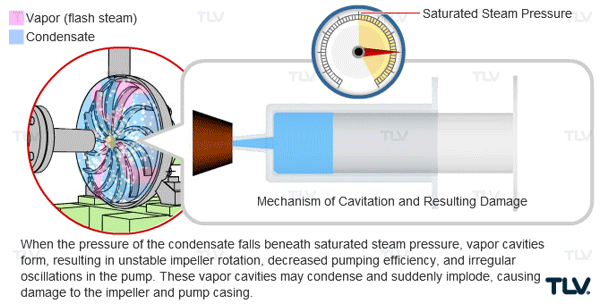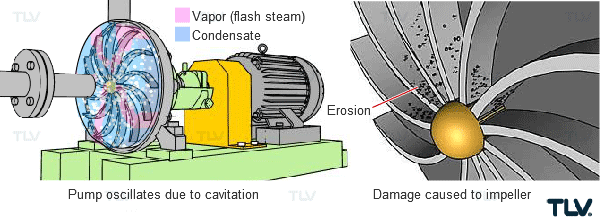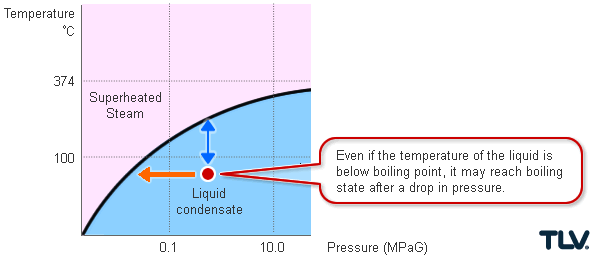- Home
- Steam Resources
- Steam Theory
- Cavitation in Condensate Pumps
Steam Trap Problems
Cavitation in Condensate Pumps
Cavitation in Condensate Pumps
Condensate pumps are designed specifically for the purpose of pumping liquid. As a result, if faced with the task of transporting a lower density vapor, the pump would have little effect and the vapor would not be moved.
This is the problem that arises when cavitation occurs in condensate pumps. Cavitation refers to the formation of vapor cavities inside the liquid being pumped, resulting in a lower density mixture of liquid and gas. This mixing of phases lowers pumping efficiency, compromising the pump's ability to pump the liquid and inviting further complications. In the world of steam, cavitation issues can commonly be found in electric condensate recovery pumps.
The Cause of Cavitation in Condensate Pumps
Cavitation specifically involves the condensate inside the pump changing into a vapor, and should not be confused with issues caused by vapor streams entering from outside of the pump. That being said, this section will take a closer look at the mechanism for the phase change from liquid to vapor inside the pump, reasons for the phase change, and practical methods to avoid cavitation.
When water nears its boiling point, some of the liquid changes phase into steam. In a pumping system, this can occur in regions of relatively lower pressure within the pump. Typically, a low-pressure region is created by the spinning of the pump’s impeller. The higher velocity results accordingly in a drop in the static pressure, and as the condensate velocity increases, the pressure decreases. This causes hot condensate to flash into steam, forming a steam void or cavity.
There are several possible factors relative to Net Positive Suction Head (NPSH) that can worsen flashing:
- High condensate temperatures result in more flashing inside the pump
- Higher speed pumps generate higher condensate velocity at the impeller and therefore incur higher localized pressure drops (ex. 3,500 RPM versus 1,750 RPM)
- Insufficient filling height at the pump inlet is not able to prevent flashing (fails to provide sufficient static head to the condensate in the volute)
- In some rare cases, restricted inlet pipe sizing can result in significant pressure drop to the pump inlet
In such instances, the local flash steam volume is high, but the latent heat content relative to the total mass of the mixture is low. Then, as flash steam continues to mix with the condensate, the flash steam cavities formed within the liquid collapse, imploding rapidly with considerable force. The rapid implosions create shockwaves that result in audible sounds. These sounds are often a first indicator to plant personnel that cavitation is occurring.
| How Cavitation Occurs in a Pump |
|---|
Damage Caused by Cavitation
Cavitation sounds serve as a sign detectable from outside the pump that internal pump damage may be occurring. These sounds are often described as similar to the sound made when shaking pebbles in a jar. Cavitation can result in damage to not only the pump itself, but also to piping and other associated equipment.
The rapid formation and implosion of vapor cavities that form via cavitation damage the inner surfaces of pumps and piping, causing the erosion and thinning of impellers and pump casing. Additionally, when not pumped effectively, condensate backs up, creating the ideal environment for corrosion to occur. Piping and equipment corrosion due to condensate back-up and erosion of the impeller and other pump components constitute two forms of damage that cannot always be observed from the exterior of the pump. Fortunately, measures can be taken to avoid such hidden issues.
| Cavitation Damage to Pump Impeller |
|---|
|
|
Mechanism & Coping Methods
As you likely are already aware, installing air vents or other gas-removing equipment will not aid in the prevention of cavitation, as those products are meant to remove gasses which have entered from outside the system and will not address the root cause of cavitation. In order to prevent cavitation, it is essential to prevent the formation of vapor cavities within the pump.
Even when the temperature of condensate entering the pump is sufficiently below boiling conditions, the risk of cavitation can still be high due to the fact that some of the liquid may flash. Flashing can occur due to a slight temperature rise or drop in pressure when there is modulation of the steam pressure, when multiple pieces of equipment discharge into a shared condensate header, when bypass valves are opened, or when steam trap leaks are not corrected.
| Boiling Point Relative to Temperature and Pressure |
|---|
|
|
The calculation of Net Positive Suction Head Available (NPSHA) and careful selection of pumps with a compatible Net Positive Suction Head Required (NPSHR) can help to reduce instances of cavitation and its resultant damage, but still there are many applications where there simply is not sufficient NPSHA for low cost electric pump products to prevent it. An increase in the condensate temperature can cause cavitation to occur in any centrifugal force pump once the available NPSH(A) is lower than required NPSH(R), so there are multiple causal items to consider.
This article does not deal with the discharge side of electric condensate pumps, but there is also the related requirement to closely calculate the Total Dynamic Head (TDH) for the system so that a pump with proper Total Discharge Pressure (TDP) can be selected. Often, the pump which is a good selection by NPSHA is not the best one for variability of TDH, but that is perhaps a topic for a different steam theory article.
Fortunately, cavitation can be completely eliminated by the use of a steam or air-powered mechanical pump as opposed to an electric-powered pump. The prevention of cavitation within condensate recovery pumps is discussed further in the latter portion of the Steam Theory article:




